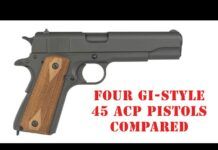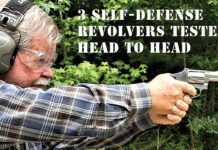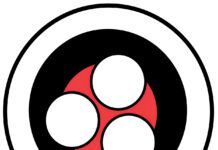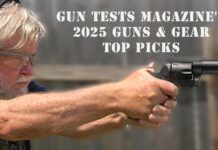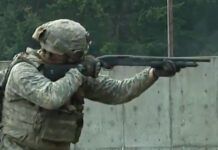Whether you’re an adherent of Cowboy Action Shooting or not, you’ve been the lucky recipient of development in guns suited for the sport, such as new or improved single-action revolvers, more choices and gunsmithing of period shotguns, and in the expansion of slide actions and levers actions in rifles. Two months ago, we compared three single-action revolvers chambered in 357 Magnum, with the nod in that test going to the Cimarron Evil Roy No. ER4104 357 Magnum, which comes from the factory tuned for fast shooting with a slicked-up action and a great trigger. If you plan to play in that game and simplify your cartridge coverage, pairing an Evil Roy with a companion 357 Mag lever-action rifle makes sense.
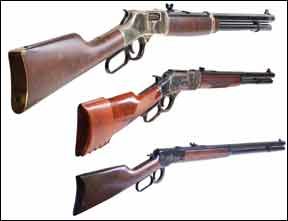
To see which rifle comes closest to taming the New West of Cowboy Action Shooting, we compared Henry’s Big Boy, Cimarron’s Evil Roy Brush Popper, and the LSI/Chiappa 1892 for fit, feel, performance, and accuracy using the same modern and cowboy action loads from the revolver test.
The first of our test lever actions was the Model 1873-style Evil Roy Brush Popper No. ER2022SS 357 Magnum/38 Special from Cimarron Firearms Co. in Fredericksburg, Texas. Cimarron gets criticism from shooters who complain that the firm’s products are overpriced, but we’re not sure that’s legitimate. We know that we almost always get what we pay for, and if we want period pieces that perform out of the box, that’s going to cost more money. Some GT readers complained that putting the Evil Roy-tuned handgun against two straight-factory guns from Ruger and Heritage was tilted too far on the customized side. But we believe that teams have to play the game in order to determine a winner, so we stuck with the Evil Roy Brush Popper, $1875, which comes with a Short Stroke Kit installed, instead of the Texas Brush Popper, still pricey at $1364. Made by Uberti in Italy, the ER Brush Popper has a real Western look, with a case-hardened-color receiver, checkered grip and forend, and a leather buttstock sheath.
Our second lever action was the Chiappa LSI Puma 1892 No. PCH-51241 357 Magnum/38 Special, $1020, based on the famous Winchester Model 92. The Model 1892 is the pistol-caliber rifle designed by John M. Browning and has been a favorite with hunters for 100 years because it was lighter, stronger, and faster than previous lever guns made in the 19th Century. Not many firearm designs today can boast of having had over 1 million produced, but the Model 1892 is one of them. Similar in construction to the Winchester Model 1886, these famous lever-action rifles have compact receivers, and when their internal components are scaled down and simplified to handle smaller calibers, the resulting rifles are light weight, produce little recoil, and have responsive, easy handling. Early Model 92s were primarily made in 44-40, 38-40, 32-20, and 25-20.
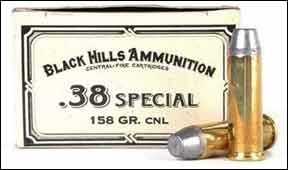
Puma’s modern-day Model 1892s, proofed for modern ammunition, are built by Armisport Chiappa in Brescia, Italy, to Browning specifications and distributed in the USA by Legacy Sports International (LegacySports.com). Currently, Puma sells eight round-barrel carbines with 20-inch barrels and blued or color-case-hardened finishes. Twelve models with 20- or 24-inch octagonal barrels and blued or color-case-hardened finishes are available. Both octagonal-barrel models hold 10 rounds in the magazine with a capacity-limited plug removed. All are available in 357 Magnum, 44/40, 44 Magnum, and 45 Colt. We picked the 24-inch barrel to assess how the longer tube affected handling, and also to see if the longer sight radius helped accuracy.
Our third gun, the Henry Big Boy No. H006M 357 Magnum/38 Special, $900, differed markedly from the other two. The Big Boy is one of many rifles from Henry Repeating Arms, based in Bayonne, New Jersey. Chambered in 44 Magnum, 45 Colt, and 357 Magnum, Henry also offers special-edition rifles in the Deluxe II, Wildlife II, or Cowboy II editions. Our test gun was the standard Big Boy in 357 Mag, fired from a monolithic brass receiver that smoothly ejects to the side, rather than out the top, as with the other guns. The Big Boy has brass appointments elsewhere, too: the yellow buttplate and barrel band combine with the blued octagon barrel to create a great overall look, we thought.
The Puma and Cimarron guns had half-cock Safe hammer positions, but the Henry, notably, did not. On all three guns, the hammer is placed at full-cocked position when the action is cycled using the lever. On the Puma and Cimarron, with a round in the chamber and the hammer at full cock, the shooter places a thumb on the hammer to firmly hold it. While holding the hammer back, he applies just enough pressure on the trigger to release it and gently lower the hammer. When the hammer is resting on the firing pin, the shooter pulls it slightly rearward until it reaches the half-cock point and clicks. In this on Safe position, pulling the trigger doesn’t release the hammer. To fire a shot, the shooter has to manually pull the hammer back to the full cock position. We didn’t have occasion to carry the guns in the field where a half-cock-safe would be helpful and fast in keeping a loaded gun just a moment away from ready to fire by pulling the hammer completely back.
The Henry firearm has a transfer-bar safety mechanism. This safety system prevents the gun from being fired under all circumstances, except when the hammer is fully cocked and the trigger is pulled. If the hammer is fully cocked and the trigger is pulled, the gun will fire as normal. However, if the hammer is fully cocked and is accidentally dislodged by some other means other than the trigger being pulled, the Henry will not fire. If the hammer is in the process of being cocked and is accidentally released and dropped into the fired down position, before it is fully cocked, the gun will not fire. The Henry rifle can be safely carried fully loaded with the hammer in the down resting position.
How We Tested
Because so many competitors shoot 38 Special ammunition in both their revolvers and lever guns to reduce recoil, we chose a designated Cowboy Action load from Black Hills Ammunition, the 158-grain 38 Special CNL (Conical Nose Lead) DCB38N1. Those rounds came from MidwayUSA (935463, $28.10/50.)
For the majority of our function testing, we bought some bulk-priced ammunition from Brownells, Winchester USA’s 130-grain Q4171 Full Metal Jackets in a 500-round bundle (105-000-023WB, $199/500 with an MTM ammo can). We rounded out the selections with Winchester USA 110-grain WINQ4204 357 Magnum Jacketed Hollow Points, also from Brownells (105-202-330WB, $31.49/50).
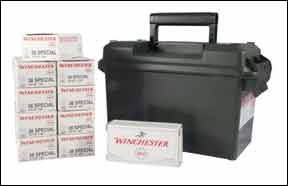
With the Black Hills 38 Special 158-grain CNLs cartridges, the Henry was half an inch more accurate (3.4-inch average group size) at 50 yards than the Cimarron (3.9 inch) and the Chiappa (4.1 inch). It gained that edge by shooting one spectacular 2.0-inch group, compared to the smallest groups for the Cimarron (3.3 inch) and the Chiappa (3.0 inch). The Henry was even more accurate with the Winchester USA 38 Special FMJs, shooting an average group size of 2.9 inches compared to the Cimarron (3.6 inches) and the Chiappa (4.6 inches). The results were the same with the 357 load, with the Henry shooting the smallest groups on average, 3.3 inches, compared to the Cimarron (4.3 inches) and the Chiappa (4.7 inches).
Speed — With Accuracy — Kills
Short-stroke kits in lever-action rifles have been around since the start of Cowboy Action Shooting. These parts kits reduce the distance it takes to lever-cock your rifle by up to 2.5 inches, allowing for faster cocking of the gun with less lever travel. For mounted shooters in particular, this makes dispatching balloons considerably easier. Some of the most reliable kits on the market come from Pioneer Gunworks (PioneerGunworks.com) and the Cowboy and Indian Store (CowboysandIndianstore.com). Each kit consists of right and left toggle link assemblies, a new lifter arm, and installation instructions. If you can disassemble and reassemble your rifle, you should be able to install your own short-stroke kit.
Only one of the rifles in this evaluation, Cimarron’s ER2022SS (the “SS” being a giveaway), had a short-stroke kit installed, as we found out when we measured the stroke travel of each one, finding a sizable difference. Measured with a dial caliper from the spot where the inside edge of the lever rested against the stock to the same spot on the lever when it was extended, the Henry had a linear stroke length of 5.94 inches, compared to the Puma’s 5.86-inch length and the Cimarron’s 4.60-inch stroke.
We don’t want to say that the stroke measurements don’t matter, but they’re only useful here for comparison. When we were shooting, what the Cimarron’s stroke length allowed us to do was anchor the right thumb on the stock and work the lever with our wrist, never losing contact with the stock. The others forced us to remove the trigger hand from the stock to work the lever fully, which cost time reacquiring the correct grip on the stock.
A common Cowboy rifle target set up is to double-tap five 16-inch-square steel targets at 15 to 20 yards, and top-level shooters can shoot 10 accurate shots in less than 5 seconds. We set up 4-inch-tall, 2-inch-wide pop-up panels 10 yards away — the smaller-than-usual targets forced us to deliver more-accurate shots, which exposed differences in the sights and stock configurations. On the clock, the Cimarron’s short-stroke kit was indeed faster than the others, getting us through 10 rounds in 10.0 seconds on average, compared to the Henry’s 10.7-second mark and the Puma bringing up the rear at 12.2 seconds. The Popper’s lever loop was the smallest in the test group, which could be trouble for shooters with large hands, but our testers felt that it gave them the ability to work the action faster.
We also noted other areas of performance where the guns differed, which we detail below.
Chiappa LSI Puma 1892 No. PCH-51241 357 Magnum/38 Special, $1020
The Puma 92 has slim and comfortable lines and looks like it would easily slip into a scabbard on your trusty mount. It has about half an inch less circumference than the others measured around the action at the loading gate and is a quarter-inch slimmer in circumference at the front of the forend. The longer barrel gave it a more graceful appearance, our team said, but what the longer tube delivered in looks it subtracted in handling. The walnut wood grain in both the buttstock and forend was straight and didn’t present a lot of figure, but the matte-gloss finish was evenly applied and showed off the wood color well, we thought. All the pores seemed to be filled, too.
Inletting around the receiver tang top and bottom was tight and level, and fit around the buttstock’s metal inserts was tight as well. The forend wood was loose, however, and it clicked when we worked the lever. Though it was period accurate, we didn’t like the buttplate at all. The sharp bottom edge of the plate would absolutely punish the shooter who was careless with a gun mount, though we admit the curved plate made making that error difficult.
Still, our testers felt that the overall appearance of the 1892 was plain compared to the Henry’s gaudy brass receiver and the Cimarron’s case-hardened-color receiver and grip and forend checkering. Also, the lack of checkering on the wood surfaces made the Puma very slick and hard to handle, especially because we had to wrestle the lever to make the Puma cycle. We lubricated the action in an attempt to smooth it out, to no avail.
During testing we noted many malfunctions, mostly elevator problems where the loading cartridge didn’t align properly with the chamber, jamming the shell in the entrance to the barrel. Most required more than just reworking the action multiple times. We usually had to force the lever down and pry the rear of the round upward to free it, then ram it home. And it didn’t seem to matter whether the capacity-reducing rod was in place or not.
We got misfeeds of the same type whether we tried to work with only five in the tube (capacity-reducing rod installed per Italian law) or with 12 in the tube (rod out, full capacity), or with 10 in the tube, (rod out, not loaded to full capacity). Our testers found that the shorter 38 Special rounds jammed less frequently than the longer 357 Magnums.
We also noted that the load gate is smaller than the others and had a much stiffer spring, making loading rounds more difficult and slower, occasionally requiring a round that was half way to be removed and reloaded at a different angle. Getting 12 in required the use of a blunt, hard-plastic tool to push the round home. The magazine tube was also loose and rattled slightly when the gun was handled.
Our Team Said: After a full day of shooting we had bruised shoulders from the sharper curvature and points on the buttplate of the Chiappa, and our hand hurt from working the stiff action and trying to handle the plentiful misfeeds. The 8.25-pound trigger was much heavier than the others, and the longer, heavier barrel made moving the gun slower and harder and offered no trade-off in better accuracy. We’d pass on this one.
Cimarron Evil Roy Brush Popper No. ER2022SS 357 Magnum/38 Special, $1875
A “brush popper” is a cowboy who works in brush country, and the name comes from his ability to extract cattle from thorny thickets. Texas author J. Frank Dobie wrote in A Vaquero of the Brush Country (1929) that “… Sam was a brush popper. Like many another brush whacker, he was wont to emerge from a thicket with enough wood hanging in the fork of his saddle to cook a side of yearling ribs.” In True Grit (1969), Rooster Cogburn (John Wayne) warns Texas Ranger La Boeuf (Glen Campbell) to stop spanking Mattie Ross (Kim Darby). When La Boeuf says he won’t stop, Cogburn draws and cocks his pistol and says, “You do and it’ll be the biggest mistake you ever made, you Texas brush-popper!”
Cimarron’s Evil Roy Brush Popper Model 1873 rifle is a light and quick lever rifle with an 18.5-inch octagon-to-round barrel with full-length tubular magazine. Their high-gloss walnut stocks come in either straight grip or pistol grip styles, the receivers are either blued or case-hardened colors, chamberings are 45 LC, 44-40, or 357 Mag./38 Special. Prices for the straight grips like our 357 Magnum Brush Popper are $1875, while the pistol-grip models run just over $80 more.
Made by Uberti in Italy and tuned by Cimarron, the Brush Popper has a real Western look, with the case-hardened receiver, checkered buttstock grip and forend, and leather buttstock sheath. We’ve already noted above that the Cimarron was faster for our shooters than the others, but it took a back seat to the Henry in accuracy with all three loads.
The stubby barrel made it the third-place finisher in terms of appearance, our team said, but shorter tube vastly improved handling — a more than equitable trade-off for our testers. We loved the rich red-brown figure in the walnut buttstock, and the high-gloss finish was perfectly filled and smooth and displayed the wood grain nicely. The grain in the forend was straight, but it was covered by functional checkering that the others lacked. We thought the Popper wouldn’t require the use of period leather gloves to shoot in hot conditions, but the other guns would.
Inletting around the receiver tang top and bottom was tight and but had some high spots we could feel. When we removed the buttplate sheath, we found the fit around the buttstock’s metal inserts was tight but also had some ridges we could feel. The bottom point of the buttplate was extremely sharp, and we’d bevel that edge if we bought the gun, sheath or no. The forend was tightly fitted, much better than the Puma and on par with the Henry, and it didn’t move at all during handling.
The smooth action suffered no misfeeds, although our testers found that with the top eject, not working the action fast enough can result in the casing falling back into the action. Our testers also noted that the top eject was potentially dangerous as well because it can throw a casing into the shooter’s face, where it can fall between the eye protection and eyes. The Chiappa had this problem as well, but the Henry’s side eject was a better system, we thought. Our testers did like the loading gate on the side of the Cimarron’s receiver, noting that it was larger and easier to use than the Chiappa’s, and faster to load than the removable tube in the Henry.
We felt the plain rear sight blade was more historically accurate but less practical, and the rear sight probably had something to do with the accuracy falloff between the Cimarron and Henry. The brass bead front sight looked like a Marble barrel-mounted front sight (such as Brownells #579-204-531, $13) that fits into the front sight dovetail cut directly into the barrel. However, we must note that tackdriver accuracy isn’t necessary for most Cowboy rifle stages. Still, we prefer the more accurate Henry in this area.
Our Team Said: The Brush Popper is a fine rifle, and choosing between it and the Henry is a toss-up for some shooters, with the Cimarron having a faster action and snappier handling. Our shooters gave the nod to the Henry because of its side ejection, better accuracy, and substantially lower price.
Henry Big Boy No. H006M 357 Magnum/38 Special, $900
An ideal companion to a pair of 357 Magnum handguns, this brass-framed rifle will compliment any Old West duds you choose to wear. The polished brass frame was set off by excellent figured walnut and nice bluing on the octagonal barrel. Henry also broke the edges of the muzzle, which made the front of the Henry much less likely to cut the shooter’s hands. The barrel band and buttplate were also brass. We preferred the execution of the Henry’s buttplate because the edges were rounded and the buttplate features much less curvature than the others. Inletting was also excellent, but with slightly larger gaps than the others at the tang and buttplate edges. But the wood-to-metal fits sat flush, which gave it an edge over the Cimarron. The clear finish showed no open pores and added a rich, muted but dent-resistant glow to the wood. The company name and caliber designations on the 20-inch barrel were gold filled.
On opening the rifle’s burgundy-colored lever, we were struck by how smooth it was. The bolt was a round bar similar to that found on Marlins. There was no obvious lever-lockout safety, but the trigger could not be pulled unless the lever was fully home. The hammer was either fully cocked or all the way down, no half-cock. But there was a hidden trigger interlock that would prevent the rifle’s firing unless the trigger were fully depressed.
The traditional buckhorn rear sight sported a white diamond that made lining up the front brass bead exact and repeatable, our shooters said. The rear assembly was set into a spring-loaded ladder for elevation changes. The rear sight sits in a dovetail slot cutout in the barrel, the base has a small a locking screw. To adjust the rifle for windage, loosen the screw and use a plastic mallet to tap it in the direction you want your hits to land. For example: if you are shooting to the left, you need to tap the sight over to the right to correct the point of impact. Conversely, if you are shooting to the right, then tap the sight to the left. We had to drift the rear slightly to get centered.
The tubular magazine held 10 rounds, and loading was easy. Twist the knurled steel end of the brass loading tube and withdraw it until the loading port is fully exposed. Elevate the muzzle slightly and drop in the required rounds. This should be done with the action closed. Press the tube back into place and give it a twist to lock it. We found this loading system to be far easier than fighting the spring-loaded gate of the Puma, but not as easy to load on the fly as the Cimarron. If you happen to bend or break your brass magazine plunger assembly, Henry offers replacements for $21.95.
For non-Cowboy use, the Henry’s side ejection would make a scope a great addition, but there were no predrilled holes to mount a scope. However, in September 2011 Henry began shipping 2nd generation Big Boy rifles, which feature receivers that are drilled and tapped for the scope mount. In 1st generation rifles, the barrels were drilled and tapped, if rollmarked “Bayonne NJ.” First-generation Big Boys like our unit use a BB-CSM Cantilever Scope Mount. The 2nd Generation (current production) rifles use the new style BB-RSM Receiver Scope Mount. All are $27.50 plus shipping from the company. There’s also a Hi-Viz sight system, $40, if you want better sights but not optics. Other accessories worth considering are large-loop levers ($50), hammer extensions ($11), and swivel kits ($17).
Our Team Said: We think this rifle is too heavy for its power — fully charged, it tipped the scales at 8.9 pounds. It had the best sights in the test and it was the most accurate with all three ammunition types. We felt that the Big Boy balanced well for quick shooting, and the lever loop was the largest and most comfortable. Our testers preferred the Cimarron’s loading gate to the removable tube in the Henry. This is not a fault with the gun, just our testers’ preference. And it’s much less than the Popper. A Best Buy.
1012-COWBOY-GUN-REPORT-CARD.pdf




